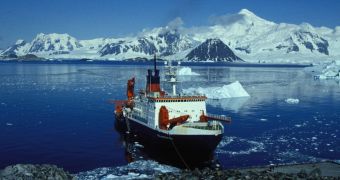Climate scientists announce that the Antarctic Peninsula is beginning to show the first signs of spring, as the Northern Hemisphere is headed into winter. The conclusion was derived from observations showing that ices have already begun melting very fast.
During winter at the South Pole, the continent is surrounded by thick, sea-based ice sheets, which prevent the land-based glaciers from slipping into the ocean. As spring comes, these ice shields start to melt, making way for a host of changes to develop in Antarctica.
The recent observations were conducted using the American's space agency's Terra satellite, which was fortunate enough to pass above the Southern Continent as the cloud cover above the Peninsula was broken apart.
The sensitive instruments aboard Terra were able to collect data about the spread of ice sheets at this sensitive location. The Peninsula is generally used as an indicator of how much global warming is affecting Antarctica.
Generally, the western parts of the continent are most affected by climate change. For many years, the eastern regions have remained intact, and even experienced an increase in the amount of ices they carried.
But, over the past few years, this changed as well, and the eastern parts of Southern Continent began melting as well. Experts around the world have been monitoring the situation in Antarctica using a large number of satellites.
In-situ measurements and scientific expeditions to the are were conducted as well. The NASA IceBridge mission is a good example of this. Already in its fourth year, the endeavor seeks to quantify how fast glaciers and ice sheets in Antarctica, the Arctic and Greenland melt and move.
The Peninsula occupies a very important spot on researchers' agenda, because of its location, and because weather stations have been collecting data in area since 1903. This provides a long-standing weather record, on which experts can track changes that affected the region.
And the influence of global warming here cannot be denied. In the last decade alone, the Larson B and Wilkins Ice Shelves both collapsed, clearing the way for land-based glaciers to flow into the ocean. These ice masses have the potential to rise sea levels around the world.
As an added negative side-effect, with the sea ices gone, the flow of land glaciers has accelerated significantly, which means that more ice is making its way into the sea than before.
Determining the influences that this has on the entire area is one of the main objectives of the IceBridge mission. The DC-8 airplane that NASA is using for the job flew above the area in 2009 as well.
Experts hope that comparing the two data sets will yield more details about the factors that have the highest influence in reshaping the region, Our Amazing Planet reports.

 14 DAY TRIAL //
14 DAY TRIAL //